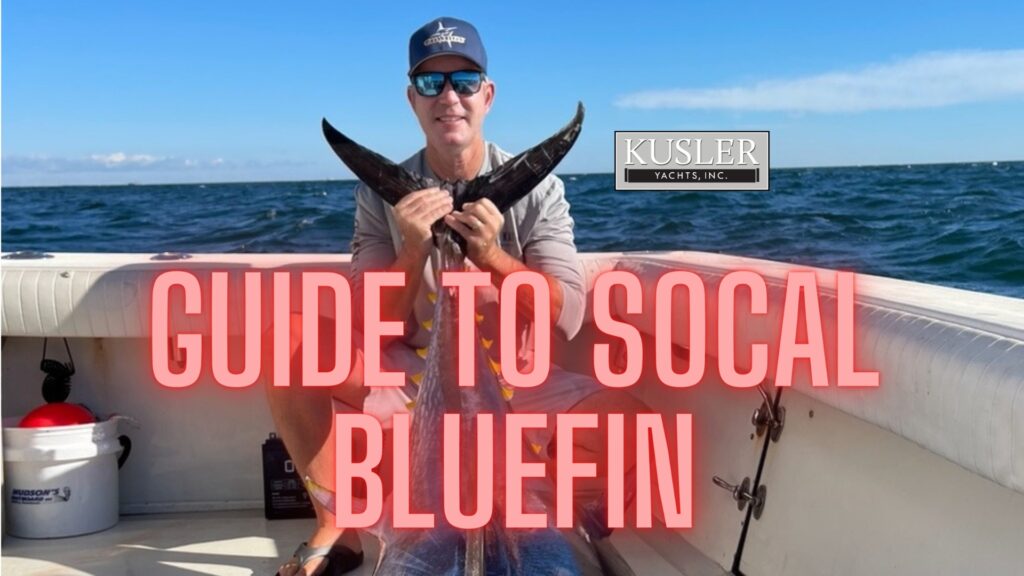
The Kusler Yachts Guide to So Cal Bluefin breaks down all you need to know about where and how to target tuna around southern California.
Within the past decade the waters off of Southern California and northern Mexico have experienced one of the most dramatic transformations in the history of sportfishing. From April through December, waves of Pacific bluefin tuna course through an area ranging from south of San Diego to north of San Clemente Island. In terms of number of fish and size, it is nothing short of world class.
The fishery seems to have developed overnight. Theories vary for why the body of fish have reappeared in this area of the Pacific after an absence of maybe 100 years. One commonly stated idea is that the fish migrated from farther east in the Pacific to the waters on this side of the world due to the amount of bait.
No matter why the fish have appeared, the southern California bluefin fishery has developed quickly—in terms of technique and participation. What follows is a breakdown of how to and where to target these fish. From the gear and tactics, to the table quality of these brutes, if you have yet to tangle with a California bluefin, here’s all the justification you need.
The Season
The bluefin season typically starts in April or May and runs through November or December. It usually follows a fairly predictable track, starting south and moving north as the season progresses.
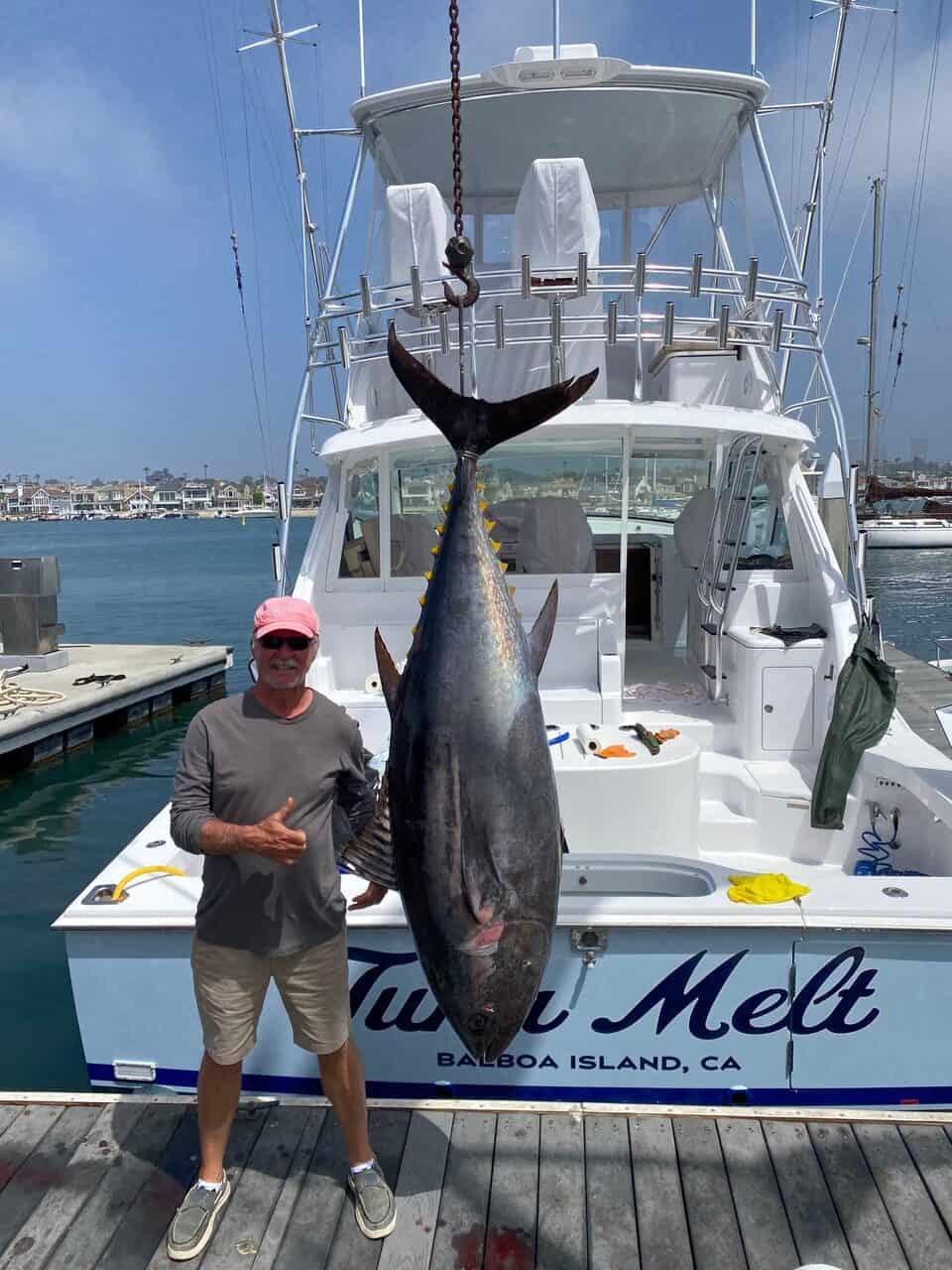
By April or May the body of fish is usually 60 or so miles south of San Diego. By May or June, the fish are generally around the US border. From late July through November, the fish range from close to the border to around San Clemente Island.
The distribution of fish varies each year and changes as the season progresses. The body of fish is further south than they were this time last year. As they move northward, the San Diego fleet and the day fleet (of the long-range boats) begin targeting them.
Just as the different stages of the season are marked by geographic distribution of the fish, each is also defined by styles of fishing. Early in the season– April and May, you’re fishing foamers. It’s run and gun tuna fishing using poppers and surface irons. As the season progresses, the focus turns to kite fishing—with dead flying fish or Yummy flyers—or slow trolling and live baiting.
As the season progresses and the body of fish begins to settle around San Clemente Island there are opportunities to target them in a number of ways.
So Cal Bluefin: Fishing Balloons
When you are fishing a dead flyer, you can set up a drift and fish fly lined baits as well as balloons. You can sometimes slow troll to tailing fish or fish that you’ve marked on the side scan sonar. You maneuver the boat to drag the bait right across them. The straight balloon—fished by bumping your engine into and out of gear to keep the bait in position—has been really effective the last couple of years.
This rig involves filling a balloon with helium and attaching it to your mainline with a rubber band. It is a bit of a balancing act. Success involves adding enough helium to lift the bait (onto the surface) but not so much that it will float away.
If you add too much helium, you can use sinkers to moderate the lift. There’s not much you can do, however, if you do not use enough helium (and your bait sinks far enough into the water for the fish to see your leader and terminal tackle).
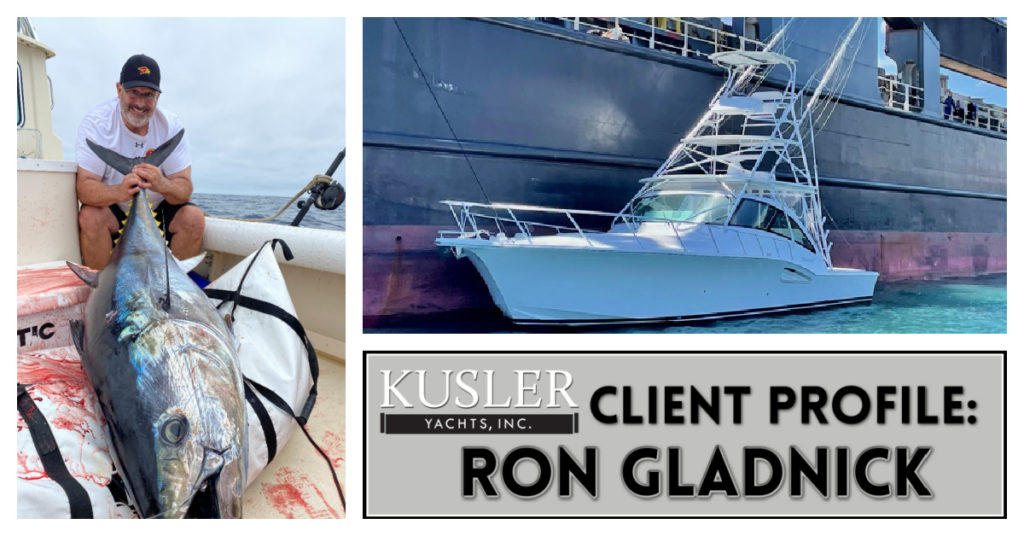
The bluefin fishing is so good in Southern California these days that it sells boats.
Once your balloons are deployed, you use the boat’s engines—bumping into and out of gear—to keep the baits in position. If you locate fish (either by seeing them tailing or by using your side scan sonar), you drive the boat ahead of them and wrap the bait over the top of the fish.
The balloons will be on the inside of your turn. Wrapping the bait describes the process of skipping them into position as you turn ahead of the fish.
For the balloon and dead bait rig, many anglers prefer a Tallica 50 spooled entirely with Spectra. You can go heavy– spooling 200, but boats typically fish between 130- and 200-pound line.
The Spectra is connected to a snap swivel. The hook and bait are then connected via a 10’ leader that consists of 200 or 300-pound fluorocarbon.
Kite Fishing for So Cal Bluefin
The kite fishing for bluefin in southern California is a distinct style from that of the kite fisherman who target sailfish in Florida. When fishing a Yummy flyer, the boat is under power running between eight and 10 knots—skipping the bait across the surface of the water.

Want to catch So Cal bluefin on your own boat? The team at Kusler Yachts can help you find the perfect boat for your needs.
When fishing a kite under power, you run the bait farther from the boat than when fishing with live baits under ballons. As such, the reels used are larger. The optimal set up for kite fishing includes Tallica 50s, Penn 70s or Tallica 80-wides.
Terminal Tackle and Bait Size
When you’re fishing California flyers, you don’t have to worry about the bait being too big. You want a bait that has the wings in good condition. Make sure not to beat the bait up too badly and keep it on ice all day when you’re not fishing it. The better the bait looks, the better chance you’ll have to get a bite.
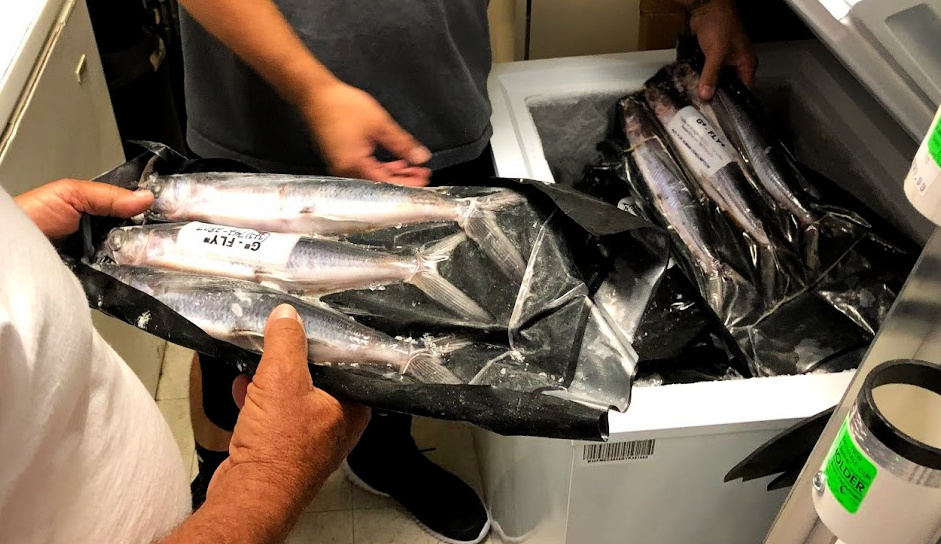
For rigging dead flyers, many captains go with two jobu style j hooks—one forward and a stinger. Some guys run a jobu in front and a treble in the back. If you do that, be sure to use a strong hook—a 4x Mustad or Owner.
Match the hooks to the size of the bait and to the size of the fish that are around. As the kite and the balloon each function to keep the leader and top of the hooks out of the water, this approach does not involve the need to scale down hook size and leader to induce bites.
A very realistic new fake flying fish came to market late last year and had great success. It’s called the California Flyer and is for sale on Instagram. It’s durable and very realistic and you can pull around at two knots. Lots of guys deploy the California Flyer as they are rigging up their baits.
The California Flyer
Jazz Moorhead makes the California Flyer in Costa Mesa. He provides a great deal of insight into the benefit of the lure and it’s point of differences.
“I was working on a 45 Sea Hunter. We’d go through 25-30 dead baits on a good day. Each one of those dead flying fish costs $30 a piece,” he says of his inspiration for the lure.
“I prototyped the first lure in March of 2020. I took a cast of a real flying fish and had the first working prototype in June. We caught a bluefin on it within a half hour of fishing it on our first trip. Over the next two or three trips we caught 10 more fish on the same lure,” he describes.
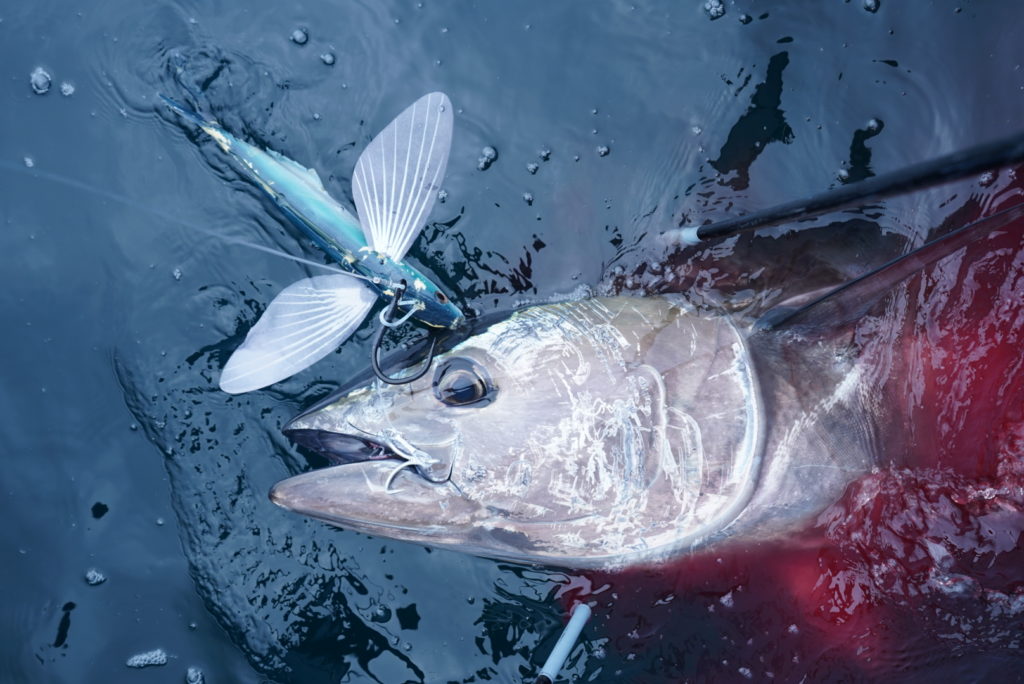
The California Flyer in action.
The California Flyer’s point of difference is not only it’s life like appearance, but it’s durability. “I gave the first series of prototypes to some friends of mine who commercially fish bluefin. Some of them have caught 20 or 40 fish on the same bait. They have teeth marks, but in terms of function they are still working great.”
The California Flyer’s durability lends itself to versatility as well. “You can slow troll the bait under a kite or balloon at one to three knots. You can troll it faster– from four to six– and on the right conditions, you can even bump it to six to eight knots.”
Moorhead provides some pointers on enticing bites under different conditions. “Some days, slow trolling around fish can entice bites. Other days, you can run over– with kites out and the lure suspended over the water– and drop the bait right on the fish.”
“One of the main benefits about the bait is the ability to fish it all day. You can run between spots at 20 knots– with your kites out and the lure suspended over the water,” Moorhead explains.
Early and Late Season Approaches
When it comes to early season popper and surface iron fishing on foamers, big Halcos are great. Surface irons are a lot of fun, too.
Captains here prefer conventional tackle (you won’t see much spinning tackle—a common choice for popper fishing in other places). If the fish are big, 150-plus, we will throw poppers on a Talica 16. It’s a lever drag, two speed reel. If the fish are under 150, we’ll use a Trinidad 20 or 30—a star drag.
Spool reels with all Spectra run to a short 100-pound fluoro leader. Some guys will fish a 60 or 80-pound mono top shot.
Later in the season, when the fish stack up around San Clemente Island there is a developing night time jig fishery. When the fish settle on the banks guys will catch them flat fall fishing using vertical jigs. Guys typically use a Talica 16 or 20.
Once you mark the fish, you set up and drop jigs. It works great with boats equipped with side scan sonar and plenty of bait and chumming power. But skiff guys get into a bit too.
Where to Go and How to Find the So Cal Bluefin
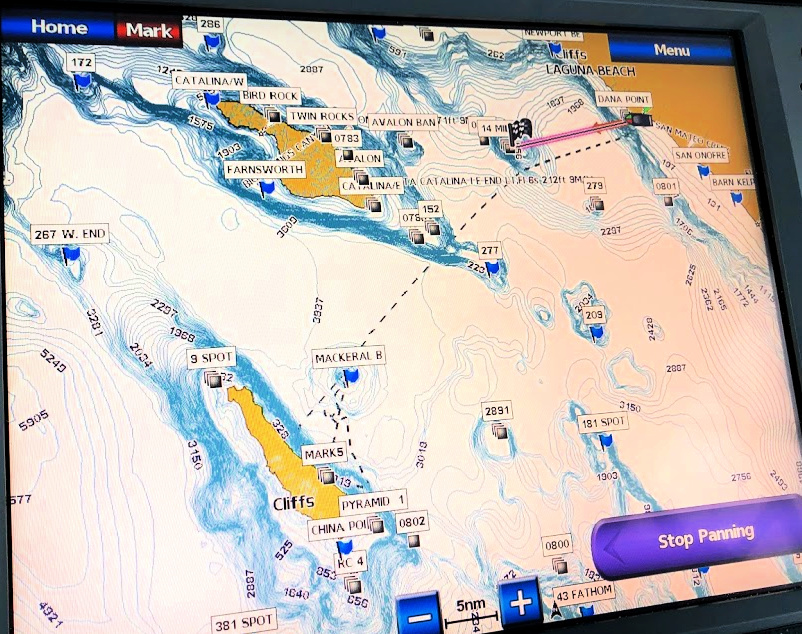
The fishing is out of San Diego in the spring and early summer. The fishing moves to Orange County and LA later in the season. Once the fish settle around San Clemente Island, you can access them from any port.
An Evolving Fishery
Steven Pinnard owns the Dana Landing, a full-service marina, tackle shop, and fuel and charter dock. His operation includes charter boats and a couple of tackle shops.
“The bluefin fishing has evolved in four or five ways. At one-point poppers were the best way to catch them. These days, most guys are kite fishing with dead or even live flying fish. There are definitely changes through time,” Pinnard says.
“Flat fall fishing is probably the most consistent way for a new guy to have success,” Pinnard explains. Much of his business involves outfitting sportfishing boats and helping people source the gear and know how necessary to catch fish.
“From how to rig baits to how to fly kites, we do a lot of that. We have boats out every night and can provide people with pointers on the way to catch fish—or the best way for them to do it (depending on their level of experience),” Pinnard concludes.
Planning Your So Cal Bluefin Trip
If you plan to target So Cal bluefin on your boat, there are some great tackle stores that can get you all set up. In addition to having the tackle, line and materials you might need, these guys are a great source for the latest on where the body of fish might be and what tactics are currently catching them. They can also show you some of the finer points on rigging and tackle prep.
Tackle Stores for So Cal Bluefin
Dana Landing. San Diego, California.
Full-service marina, charter and fuel dock and offshore tackle outfitter that offers everything you need for So Cal bluefin fishing.
Melton International Tackle. Anaheim, California.
Melton Tackle not only has an impressive brick and mortar facility, but are a leader in catalog and internet tackle sales.
Charter and Long-Range Boats
There are also plenty of great charter options to get you on bluefin. These can be a great option for the prospective—or novice boat owner—to get dialed into the best practices in a hurry. Not only will you learn quite a bit, but you might catch the fish of lifetime while doing it.
Fisherman’s Landing, San Diego.
Home to a fleet of charter boats and long-range vessels that can target bluefin throughout the season—locally and into Mexico.
www.Fishermanslanding.com
Pinnacle Sportfishing, Capt. Duane “Diego” Mellor.
With its fleet of three Parkers, Pinnacle Sportfishing is recognized for its ability to consistently catch big So Cal bluefin… among other species. www.pinnaclesportfishing.com